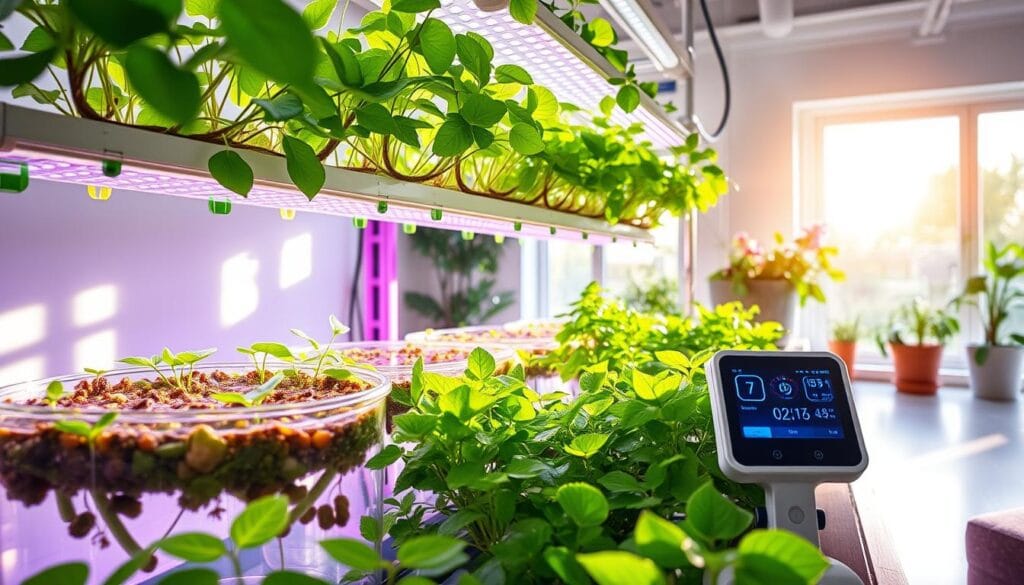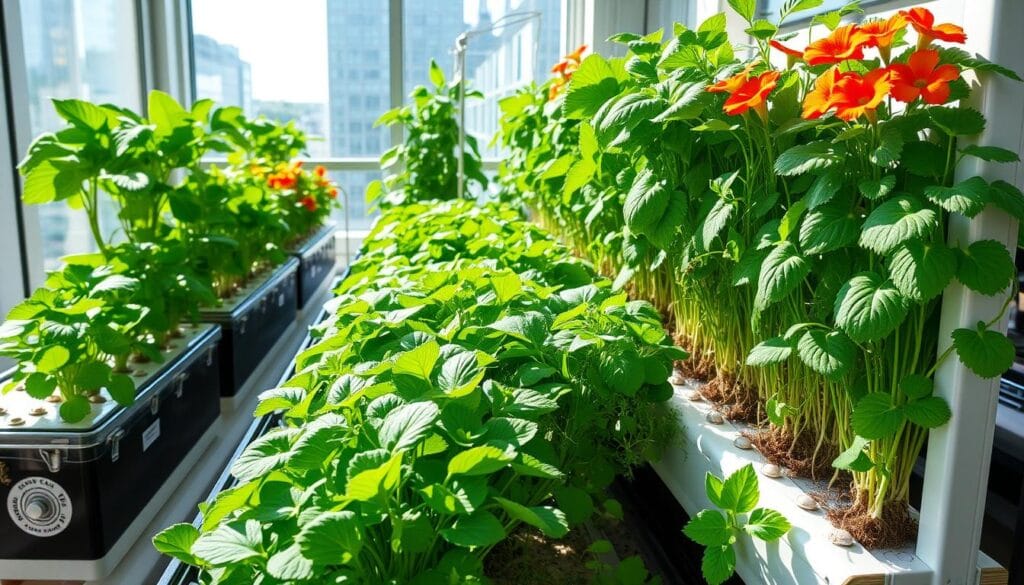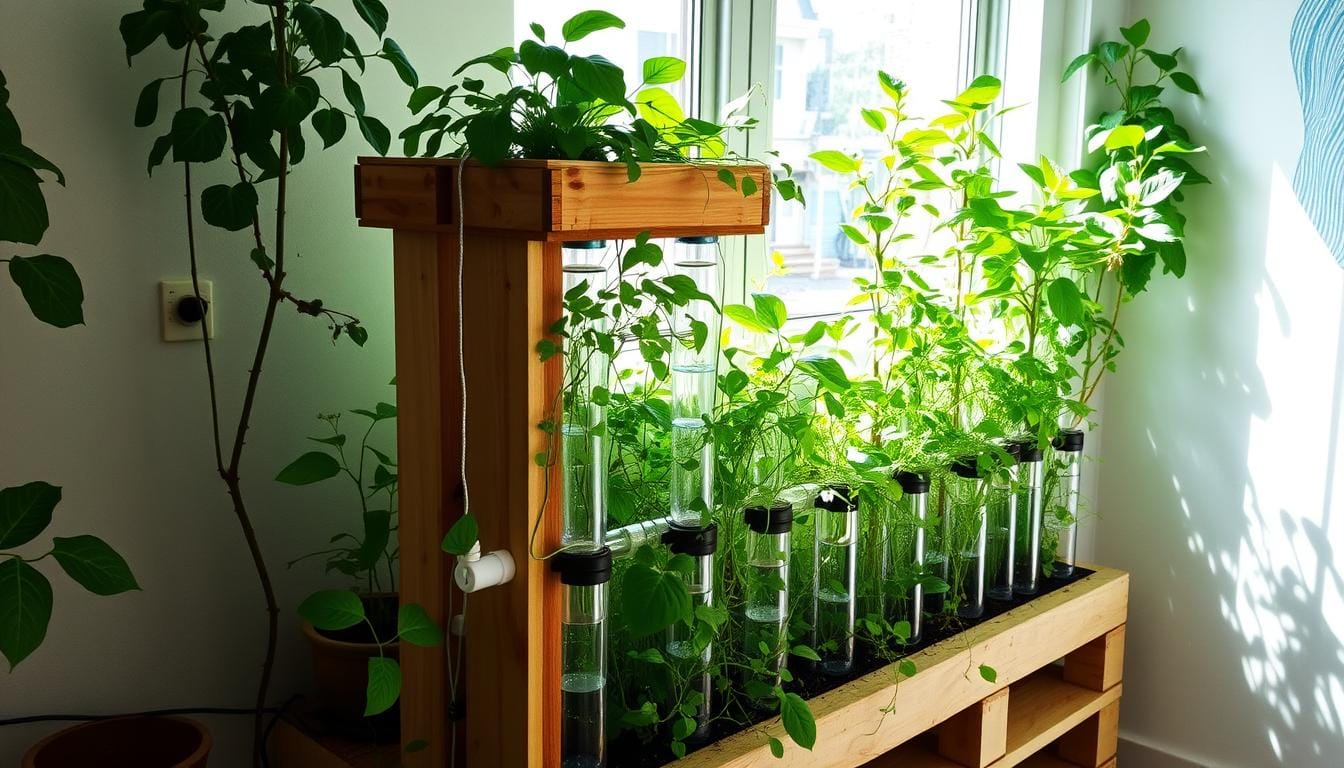Eco-Friendly DIY Hydroponic System Ideas can transform your kitchen into a thriving garden filled with fresh herbs and vibrant veggies. Imagine entering your kitchen and being greeted by the delightful aroma of homegrown produce. This isn’t just a dream—it’s the reality of using an eco-friendly hydroponic system to create a self-sufficient garden right at home.
Hydroponic gardening is revolutionizing urban farming. It’s a sustainable and innovative way to grow food year-round. From leafy greens and fragrant herbs to juicy tomatoes and sweet strawberries, you can cultivate a variety of plants without soil or extensive outdoor space.
Whether you’re new to gardening or have experience, you can create your own hydroponic system. You can make vertical gardens, use old containers, or even set up a system in your window. These methods are good for the planet and give you fresh food all the time.
Key Takeaways
- Hydroponic gardening offers a sustainable, soil-free solution for growing fresh produce indoors year-round.
- DIY hydroponic systems can be customized to fit a variety of indoor spaces, from small windowsills to larger vertical walls.
- Eco-friendly materials and water-based nutrient solutions make hydroponic gardening an environmentally conscious choice.
- Hydroponic systems allow for efficient water usage and can produce up to 30% more yield than traditional soil-based gardening.
- A wide range of plants, from leafy greens to fruiting crops, can thrive in a properly designed hydroponic setup.
Understanding Basic Hydroponic Principles
Hydroponics is a soilless way to grow food that’s becoming more popular. It lets people grow their own organic food and be more self-sufficient. This method is based on a deep understanding of hydroponic science.
The Science Behind Soilless Growing
Hydroponics is different from regular gardening. It grows plants in water, not soil. This way, plants get nutrients directly from the water. This makes them grow faster and produce more than they would in soil.
Essential Components of Hydroponic Systems
- Water reservoir: Holds the nutrient-rich water that nourishes the plants.
- Nutrient solution: A carefully formulated blend of essential minerals and vitamins that fuels plant growth.
- Growing medium: A soilless material, such as coco coir or perlite, that supports the plants’ roots.
- Air pump (optional): Provides oxygenation to the root system, promoting healthier plant development.
Benefits of Hydroponic Gardening
Hydroponic gardening has many benefits. It’s great for those who want to grow food without soil. The advantages include:
- Hydroponic systems promote water conservation, using up to 90% less water compared to traditional gardening methods.
- Faster growth rates: Plants in hydroponic systems grow faster and produce more food.
- Limited space requirements: Hydroponic setups can fit in even the smallest spaces, making it perfect for self-sufficiency.
- Precise nutrient control: Growers can control and adjust nutrient levels for better plant health and productivity.
Learning about hydroponic gardening opens up new possibilities. It lets people grow their own organic food and live more self-sufficiently.
“Hydroponics is not just a trend – it’s a sustainable solution for the future of agriculture.”
Getting Started with DIY Hydroponics Equipment
If you’re into urban agriculture or indoor farming, a DIY hydroponic system is a great start. Hydroponics grows plants without soil, making it eco-friendly and efficient. Create a thriving garden and grow your food indoors.
To start your DIY hydroponic project, you’ll need basic stuff like PVC pipes and net cups. You’ll also need a water pump and a growing medium like rockwool. It’s important to monitor the system with sensors for temperature, humidity, and pH levels. You can even use a Raspberry Pi for a smart monitoring setup.
Choose seeds that germinate quickly, like arugula, basil, and lettuce. Start germination by placing seeds in damp paper towels in sealed bags. This creates a humid environment for sprouting.
- Different types of DIY hydroponic systems include Deep Water Culture (DWC), Nutrient Film Technology (NFT), Kratky method, Recirculating, Wick, Water Culture, Ebb and Flow, and Aeroponic systems.
- Wick hydroponic systems are simple and affordable, making them ideal for beginners and schools.
- Deep Water Culture (DWC) hydroponic systems allow plants to grow directly in nutrient solutions without soil.
- The Ebb and Flow hydroponic system involves circulating water using aquarium pumps, making it beginner-friendly.
Learning about hydroponic equipment and techniques helps you create a thriving indoor garden. It supports your urban agriculture or self-sufficiency goals.
| Hydroponic System | Key Features | Suitability |
|---|---|---|
| Nutrient Film Technique (NFT) | Continuous flow of nutrient-rich water over plant roots | Ideal for beginners and advanced growers |
| Aeroponic | Mist environment for plant growth, uses 90% less water | Popular for small-scale gardening |
| Ebb and Flow | Circulates water using aquarium pumps | Beginner-friendly |
Eco-Friendly DIY Hydroponic System Ideas
DIY hydroponic systems are becoming more popular for those who care about the environment. They save space, use less water, and are better for the planet. Here are some cool DIY hydroponic ideas you can try at home.
Vertical Wall Gardens
Vertical wall gardens are great for saving space. You can use PVC pipes or old materials like gutters. They let you grow many plants in a small area, perfect for city living.
When making your vertical garden, think about water depth and how easy it is to clean. Also, make sure it’s sturdy to last a long time.
Recycled Container Systems
Turning old items into hydroponic systems is a smart way to go green. You can use plastic bottles, buckets, or wooden crates. It’s affordable and environmentally friendly.
Make sure your system has cleanout valves for upkeep. Also, make sure it gets enough light for all plants.
Window-Mounted Solutions
Window-mounted systems are perfect for city folks with little outdoor space. They use your window’s natural light to grow plants. You can grow herbs, greens, or small veggies right in your home.
When picking a window system, look at water depth, support, and design. This helps with easy upkeep and access.
Choosing eco-friendly DIY hydroponics is key for a green garden. It saves space, water, and uses old stuff. You’ll have a great indoor garden that’s good for the planet.
| DIY Hydroponic System Ideas | Key Considerations |
|---|---|
| Vertical Wall Gardens |
|
| Recycled Container Systems |
|
| Window-Mounted Solutions |
|
“Hydroponic systems can produce up to 10 times more yield than soil-based gardens, according to NASA.”
The Kratky Method: A Passive Hydroponic Approach
Discover the Kratky Method, a simple way to grow plants without pumps or electricity. It’s great for those who want to save water and grow organic produce at home.
Plants in the Kratky Method sit in net pots over a water reservoir. As plants grow, the water level goes down. This creates a space for oxygen, helping the roots breathe. It’s a hands-off way to grow plants, providing them with what they need.
“The Kratky Method is a completely passive system, eliminating the need for electricity, pumps, or wicks. It’s an ideal choice for those new to hydroponics or looking for a hands-off approach to growing their own fresh produce.”
The Kratky Method is ideal for cultivating leafy greens and fresh herbs. It’s also great for those with little outdoor space. It’s easy to use, making it perfect for classrooms and families.
Whether you’re new to gardening or experienced, the Kratky Method is rewarding. It’s an eco-friendly and sustainable method to grow your own food. Try it and enjoy fresh, healthy produce.
Building a Nutrient Film Technique (NFT) System
Starting a soilless cultivation project with an NFT system can change your urban agriculture game. This DIY hydroponic system lets you grow many plants without soil. Here’s how to make your own NFT setup.
Materials and Tools Required
To make an NFT system, you’ll need a few things:
- Several 3-inch PVC pipes for the grow channels
- A good water pump
- Net cups for plant support
- Growing mediums such as coco coir and expanded clay pebbles
Step-by-Step Assembly Guide
Begin by cutting the PVC pipes to the right length. Make sure they slope about 3% for water flow. Drill 36 holes, spaced 25cm, 55cm, and 85cm from one end, for net cups. Put the pump at the top to keep the solution moving.
Fill the net cups with growing medium and plant your seeds.
Maintenance Tips
Keeping your NFT system clean is key. Clean the channels often and check the nutrient levels. Change the water every two to three weeks to keep plants healthy. Use cleaning valves and a pulley system for light adjustments.
By following these steps, you can build a great soilless cultivation system. It’s perfect for urban agriculture. Start with eco-friendly DIY hydroponic system ideas and watch your plants thrive!
Smart Monitoring Solutions for Hydroponic Gardens
Indoor farming is becoming more popular for self-sufficiency and sustainable gardening. It’s crucial to use smart monitoring solutions for a healthy hydroponic garden. Technology helps manage your indoor sustainable gardening setup and keeps your plants thriving.
Start with a Raspberry Pi-powered monitoring system in your hydroponic garden. This small computer tracks important factors like temperature, humidity, and pH levels. By adding sensors, you get continuous data and updates on your garden’s health.
Adding a webcam to your setup is also a good idea. It captures time-lapse images of your plants’ growth. This visual data helps you understand your plants’ health and make better growing decisions.
For easier garden management, look into custom-built apps like Viam. These apps can combine all your monitoring data. This makes it simple to check and analyze your garden’s conditions, helping you improve your growing methods.
Smart monitoring solutions make it easy to keep your indoor farming environment perfect. This ensures your plants grow well and boosts your self-sufficiency and sustainable gardening efforts.

“Embracing technology in your hydroponic garden can be a game-changer, empowering you to achieve remarkable results in your self-sufficiency and sustainable gardening journey.”
Sustainable Nutrient Management
Keeping your hydroponic system eco-friendly starts with organic nutrient solutions. These solutions feed your plants and support sustainable gardening. Choosing the right organic nutrients and keeping their balance ensures your plants grow well and helps the environment.
Organic Nutrient Solutions
For hydroponic systems, organic nutrients are best. Look for fertilizers made from natural sources like seaweed, fish emulsions, or compost teas. These options give plants the nutrients they need without synthetic chemicals.
Water Conservation Techniques
Hydroponic gardening is great for saving water. Use water conservation techniques to make your system even more efficient. Systems that reuse nutrient solution can cut down on water waste. Also, managing nutrients well helps use less water.
Checking pH levels regularly is key for plant health. Use a pH sensor to keep the levels between 5.5 and 6.5. This ensures plants absorb nutrients well.
Choosing organic nutrients and saving water makes your hydroponic garden sustainable. It grows plenty of organic produce while being kind to the environment.
| Organic Nutrient Solution | Advantages | Considerations |
|---|---|---|
| Seaweed Extracts | Rich in micronutrients, growth hormones, and beneficial compounds | May require higher application rates than synthetic fertilizers |
| Fish Emulsions | Provide a natural source of nitrogen and other nutrients | Potential odor concerns, especially during application |
| Compost Teas | Contain a diverse array of beneficial microorganisms | Require careful preparation and monitoring for optimal effectiveness |
Using organic nutrients and saving water are key to a green hydroponic system. These steps help your garden grow well and support the environment.
Choosing the Right Plants for Your System
Starting with organic produce and urban agriculture in a sustainable gardening way means picking the right plants. Leafy greens, herbs, and small veggies do well without soil. They give you a lot of food with little work.
Choose plants like lettuce, spinach, arugula, basil, and bok choy for your hydroponic garden. Avoid big root veggies in small systems. Make sure plants have enough room and light.

Start with green onions for an easy win. They grow fast, in just 3-4 weeks. You can grow them many times, making you more confident in urban agriculture.
- Leafy greens like lettuce and spinach do great in Nutrient Film Technique (NFT) systems. They grow fast and have shallow roots.
- Basil and cucumbers love Deep Water Culture (DWC) setups. They get lots of air.
- Flood and drain (ebb and flow) systems work well with many plants. Try strawberries, tomatoes, and herbs.
As you get better, try different organic produce. Grow nutritious greens, tasty herbs, and even flowers like marigolds and pansies. With the right info and setup, your sustainable gardening project can be very rewarding.
Lighting Solutions and Energy Efficiency
Use energy-efficient LED grow lights to help or replace natural light in your eco-friendly DIY hydroponic system. LED lights give the right light spectrums for each growth stage. This ensures your plants get the light they need for photosynthesis and growth.
LED Growing Lights
LED grow lights are great for sustainable gardening and indoor farming. They use little electricity but give a lot of light. This means less waste and energy use. Plus, LEDs cool down plants, which might cut down on the need for extra climate control.
Natural Light Integration
Try to use natural light in your hydroponic setup by placing it near windows. This cuts down on artificial lighting needs and lets plants enjoy sunlight’s full spectrum. Use a pulley system to move lights up as plants grow. This ensures all plants get the right amount of light.

